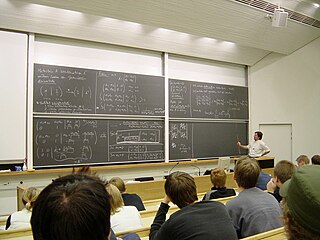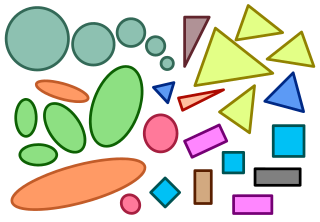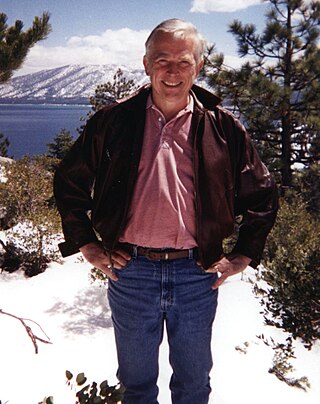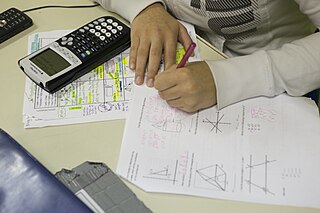Related Research Articles

In contemporary education, mathematics education—known in Europe as the didactics or pedagogy of mathematics—is the practice of teaching, learning, and carrying out scholarly research into the transfer of mathematical knowledge.

Michael David Spivak was an American mathematician specializing in differential geometry, an expositor of mathematics, and the founder of Publish-or-Perish Press. Spivak was the author of the five-volume A Comprehensive Introduction to Differential Geometry.

New Mathematics or New Math was a dramatic but temporary change in the way mathematics was taught in American grade schools, and to a lesser extent in European countries and elsewhere, during the 1950s–1970s. Curriculum topics and teaching practices were changed in the U.S. shortly after the Sputnik crisis. The goal was to boost students' science education and mathematical skills to compete with Soviet engineers, reputedly highly skilled mathematicians.

David Orlin Hestenes is a theoretical physicist and science educator. He is best known as chief architect of geometric algebra as a unified language for mathematics and physics, and as founder of Modelling Instruction, a research-based program to reform K–12 Science, Technology, Engineering, and Mathematics (STEM) education.
John Harold Saxon Jr. was an American mathematics educator who authored or co-authored and self-published a series of textbooks, collectively using an incremental teaching style which became known as Saxon math.
Principles and Standards for School Mathematics (PSSM) are guidelines produced by the National Council of Teachers of Mathematics (NCTM) in 2000, setting forth recommendations for mathematics educators. They form a national vision for preschool through twelfth grade mathematics education in the US and Canada. It is the primary model for standards-based mathematics.
Founded in 1920, The National Council of Teachers of Mathematics (NCTM) is a professional organization for schoolteachers of mathematics in the United States. One of its goals is to improve the standards of mathematics in education. NCTM holds annual national and regional conferences for teachers and publishes five journals.

Elementary mathematics, also known as primary or secondary school school mathematics, is the study of mathematics topics that are commonly taught at the primary or secondary school levels around the world. It includes a wide range of mathematical concepts and skills, including number sense, algebra, geometry, measurement, and data analysis. These concepts and skills form the foundation for more advanced mathematical study and are essential for success in many fields and everyday life. The study of elementary mathematics is a crucial part of a student's education and lays the foundation for future academic and career success.

David Eugene Smith was an American mathematician, educator, and editor.

Core-Plus Mathematics is a high school mathematics program consisting of a four-year series of print and digital student textbooks and supporting materials for teachers, developed by the Core-Plus Mathematics Project (CPMP) at Western Michigan University, with funding from the National Science Foundation. Development of the program started in 1992. The first edition, entitled Contemporary Mathematics in Context: A Unified Approach, was completed in 1995. The third edition, entitled Core-Plus Mathematics: Contemporary Mathematics in Context, was published by McGraw-Hill Education in 2015.
Traditional mathematics was the predominant method of mathematics education in the United States in the early-to-mid 20th century. This contrasts with non-traditional approaches to math education. Traditional mathematics education has been challenged by several reform movements over the last several decades, notably new math, a now largely abandoned and discredited set of alternative methods, and most recently reform or standards-based mathematics based on NCTM standards, which is federally supported and has been widely adopted, but subject to ongoing criticism.
Investigations in Numbers, Data, and Space is a K–5 mathematics curriculum, developed at TERC in Cambridge, Massachusetts, United States. The curriculum is often referred to as Investigations or simply TERC. Patterned after the NCTM standards for mathematics, it is among the most widely used of the new reform mathematics curricula. As opposed to referring to textbooks and having teachers impose methods for solving arithmetic problems, the TERC program uses a constructivist approach that encourages students to develop their own understanding of mathematics. The curriculum underwent a major revision in 2005–2007.
Reform mathematics is an approach to mathematics education, particularly in North America. It is based on principles explained in 1989 by the National Council of Teachers of Mathematics (NCTM). The NCTM document Curriculum and Evaluation Standards for School Mathematics (CESSM) set forth a vision for K–12 mathematics education in the United States and Canada. The CESSM recommendations were adopted by many local- and federal-level education agencies during the 1990s. In 2000, the NCTM revised its CESSM with the publication of Principles and Standards for School Mathematics (PSSM). Like those in the first publication, the updated recommendations became the basis for many states' mathematics standards, and the method in textbooks developed by many federally-funded projects. The CESSM de-emphasised manual arithmetic in favor of students developing their own conceptual thinking and problem solving. The PSSM presents a more balanced view, but still has the same emphases.
Clement Vavasor Durell was an English schoolmaster who wrote mathematical textbooks.

Roland "Ron" Edwin Larson is a professor of mathematics at Penn State Erie, The Behrend College, Pennsylvania. He is best known for being the author of a series of widely used mathematics textbooks ranging from middle school through the second year of college.

Mathematics education in the United States varies considerably from one state to the next, and even within a single state. However, with the adoption of the Common Core Standards in most states and the District of Columbia, mathematics content across the country is moving into closer agreement for each grade level. The SAT, a standardized university entrance exam, has been reformed to better reflect the contents of the Common Core. However, many students take alternatives to the traditional pathways, including accelerated tracks. As of 2023, twenty-seven states require students to pass three math courses before graduation from high school, but seventeen states and the District of Columbia require four.
Ian Robertson Porteous was a Scottish mathematician at the University of Liverpool and an educator on Merseyside. He is best known for three books on geometry and modern algebra. In Liverpool he and Peter Giblin are known for their registered charity Mathematical Education on Merseyside which promotes enthusiasm for mathematics through sponsorship of an annual competition.
Modern elementary mathematics is the theory and practice of teaching elementary mathematics according to contemporary research and thinking about learning. This can include pedagogical ideas, mathematics education research frameworks, and curricular material.
A mathematical exercise is a routine application of algebra or other mathematics to a stated challenge. Mathematics teachers assign mathematical exercises to develop the skills of their students. Early exercises deal with addition, subtraction, multiplication, and division of integers. Extensive courses of exercises in school extend such arithmetic to rational numbers. Various approaches to geometry have based exercises on relations of angles, segments, and triangles. The topic of trigonometry gains many of its exercises from the trigonometric identities. In college mathematics exercises often depend on functions of a real variable or application of theorems. The standard exercises of calculus involve finding derivatives and integrals of specified functions.
The Secondary School Mathematics Curriculum Improvement Study (SSMCIS) was the name of an American mathematics education program that stood for both the name of a curriculum and the name of the project that was responsible for developing curriculum materials. It is considered part of the second round of initiatives in the "New Math" movement of the 1960s. The program was led by Howard F. Fehr, a professor at Columbia University Teachers College.
References
- 1 2 3 4 5 James Nickel (2004). "The Mathematics textbooks authored by Harold R. Jacobs: An Analysis" (PDF).
- 1 2 3 Cathy Duffy (September 5, 2018). "Jacobs' Elementary Algebra".
- ↑ "Mathematics, a Human Endeavor".
- ↑ "Art of Mathematics: Project History".
- ↑ Susan Knueven Wong. Student Workbook for Jacobs Mathematics: A Human Endeavor. ISBN 978-071-672-539-8.
- ↑ Harold R. Jacobs. Mathematics, a Human Endeavor: A Textbook for Those Who Think They Don't Like the Subject. ISBN 071-67-0439-0.
- ↑ "Mathematics, a Human Endeavor: A Book for Those Who Think They Don't Like the Subject".
- ↑ D. Burnett (January 2007). "Learning: The Journey of a Lifetime".
- ↑ Joshua Paul Abrams (2001). "Mathematical Modeling: Teaching the Open-ended Application of Mathematics" (PDF). Retrieved March 2, 2020.
- ↑ Teacher's Guide: Harold R. Jacobs. Geometry (Teacher Guide). ISBN 9781683440222.
- ↑ Maria Miller. "Review of Harold Jacobs Geometry: Seeing, Doing, Understanding (third edition)".
- ↑ Harold R. Jacobs (1979). Elementary Algebra . ISBN 9780716710479.
- ↑ Teacher's Guide: Harold R. Jacobs. Teacher's Guide to Elementary Algebra. ISBN 9780716710752.
- ↑ Elementary Algebra 0th Edition. ISBN 0716710471.
- ↑ C. Hollis Crossman. "Harold Jacobs Mathematics".